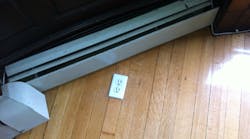How well do you know the Code? Think you can spot violations the original installer either ignored or couldn't identify? Here's your chance to moonlight as an electrical inspector and second-guess someone else's work from the safety of your living room or office. It's your turn to identify the violation.
Hint: yes, that’s a wood floor
Find the Answer
Well, I think this installer took the cheap way out. Instead of using a box that is specifically listed for receptacles installed in floors, it appears as though he used a general purpose type of “old work” style device box to install this receptacle. This is in direct violation of Sec. 314.27(B), which requires boxes for this application to be specifically listed for this type of use. Listed floor boxes provide a greater degree of protection for the receptacle and are designed to handle the weight that may be put on them if a person were to step directly on the box. In addition, this receptacle has no protection from spilled liquids or damage from somebody stepping on the receptacle. Spilled liquids or a broken receptacle could cause arcing and sparking, which could result in a fire. The Exception in Sec. 314.27(B) does allow the AHJ to approve other types of boxes for receptacles that are installed in raised floors of show windows where there is no exposure to physical damage, moisture or dirt. However, this Exception does not apply in this particular installation.




